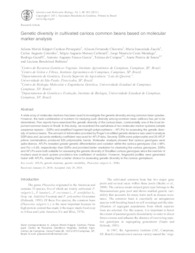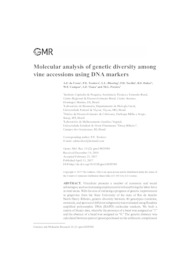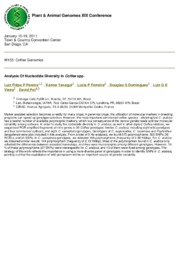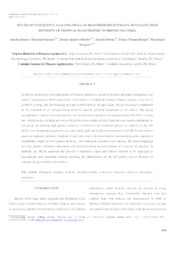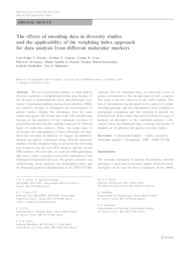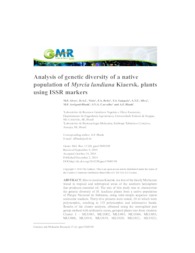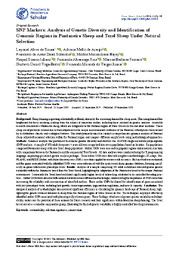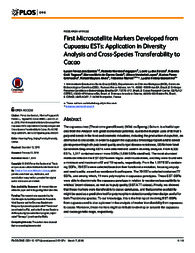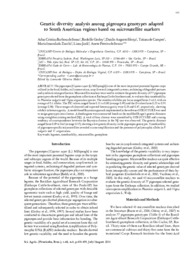Search Publications
Filter by:
| Author(s): PERSEGUINI, J. M. C. K.; CHIORATTO, A. F.; ZUCCHI, M. I.; COLOMBO, C. A.; CARBONELL, S. A. M.; MONDEGO, J. M. C.; GAZAFFI, R.; GARCIA, A. A. F.; CAMPOS, T. de; SOUZA, A. P. de; RUBIANO, L. B. A wide array of molecular markers has been used to investigate the genetic diversity among common bean species. However, the best combination of markers for studying such diversity among common bean c... ... |
| Author(s): COSTA, A. F. da; TEODORO, P. E.; BHERING, L. L.; TARDIN, F. D.; DAHER, R. F.; CAMPOS, W. F.; VIANA, A. P.; PEREIRA, M. G. Viticulture presents a number of economic and social advantages, such as increasing employment levels and fixing the labor force in rural areas. With the aim of initiating a program of genetic improve... ... |
| Author(s): PEREIRA, L. F. P.; YANAGUI, K.; FERREIRA, L. P.; DOMINGUES, D. S.; VIEIRA, L. G. E.; POT, D
|
| Author(s): DELAMUTA, J. R. M.; RIBEIRO, R. A.; MENNA, P.; BANGEL, E. V.; HUNGRIA, M. Symbiotic association of several genera of bacteria collectively called as rhizobia and plants belonging to the family Leguminosae (=Fabaceae) results in the process of biological nitrogen fixation, p... ... |
| Author(s): FERRÃO, L. F. V.; CAIXETA, E. T.; CRUZ, C. D.; SOUZA, F. de F.; FERRAO, M. A. G.; ZAMBOLIM, Z.; SAKIYAMA, N. S. The use of molecular markers to study genetic diversity represents a breakthrough in this area, because of the increase in polymorphism levels and phenotypic neutrality. Codominant markers, such as mi... ... |
| Author(s): ALVES, M. F.; NIZIO, D. A. C.; BRITO, F. A.; SAMPAIO, T. S.; MUNIZ, A. V. C. da S.; ARRIGONI BLANK, M. F.; CARVALHO, S. V. A.; BLANK, A. F. Myrcia lundiana Kiaersk. is a tree of the family Myrtaceae found in tropical and subtropical areas of the southern hemisphere that produces essential oil. The aim of this study was to characterize the... ... |
| Author(s): LOPES, H. M.; BASTOS, C. S.; BOITEUX, L. S.; FORESTI, J.; SUINAGA, F. A. Therefore, the aim of this study was to determine the genetic diversity of H. armigera and H. zea populations by RAPD-PCR analysis. The most important result was the clustering of one H. armigera popu... ... |
| Author(s): SOUSA, L. A. de; ARAUJO, A. M. de; DINIZ SOBRINHO, F. de A.; BAJAY, M. M.; JULIANO, R. S.; REIS, F. A.; FERREIRA, M. B.; VEGA-BRITEZ, G. D.; VARGAS JUNIOR, F. M. de Sheep farming is growing substantially in Brazil, driven by the increasing demand for sheep meat. This rising demand has heightened the focus on sheep, making them the subject of numerous studies, inc... ... |
| Author(s): SANTOS, L. F. dos; FREGAPANI, R. M.; FALCAO, L. L.; TOGAWA, R. C.; COSTA, M. M. do C.; LOPES, U. V.; GRAMACHO, K. P.; ALVES, R. M.; MICHELI, F.; MARCELLINO, L. H. The cupuassu tree (Theobroma grandiflorum) (Willd. ex Spreng.) Schum. is a fruitful species from the Amazon with great economical potential, due to the multiple uses of its fruit´s pulp and seeds in t... ... |
| Author(s): SOUSA, A. C. B.; GODOY, R.; SFORÇA, D. A.; CAMPOS, T. de; ZUCCHI, M. I.; JANK, L.; SOUZA, A. P. de The pigeonpea [Cajanus cajan (L) Millspaugh] is one of the most important perennial legume crops utilized in the food, fodder, soil conservation, crop-livestock integrated systems, reclaiming of degra... ... |
Observation
Some of Embrapa's publications are published as ePub files. To read them, use or download one of the following free software options to your computer or mobile device. Android: Google Play Books; IOS: iBooks; Windows and Linux: Calibre.
Access other publications
Access the Agricultural Research Database (BDPA) to consult Embrapa's full library collection and records.
Visit Embrapa Bookstore to purchase books and other publications sold by Embrapa.

